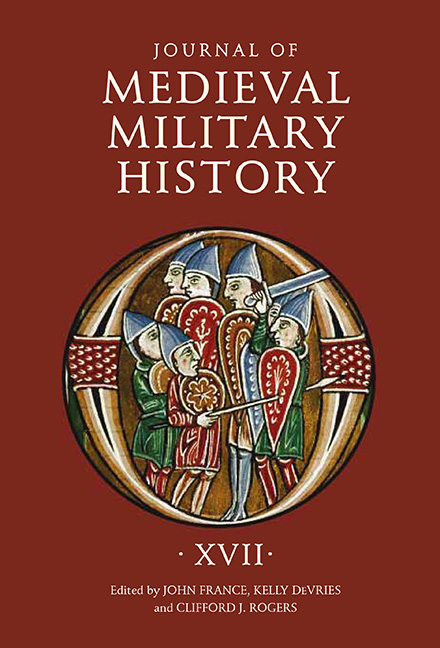Book contents
- Frontmatter
- Contents
- List of Illustrations
- 1 Baktash the Forgotten: The Battle of Tell Bashir (1108) and the Saljuq Civil Wars
- 2 The External Fortifications of ʿAtlit Castle, the Only Unconquered Crusader Stronghold in the Holy Land
- 3 Holy Warriors, Worldly War: Military Religious Orders and Secular Conflict
- 4 Elionor of Sicily: A Mediterranean Queen’s Two Lives of Family, Administration, Diplomacy, and War
- 5 Wives, Mistresses, Lovers, and Daughters: The Fortunes of War for Royal Women in Late Fourteenth Century Castile. OR: A Gender Limitation on Writing History from Chronicles
- 6 The Lance in the Fifteenth Century: How French Cavalry Overcame the English Defensive System in the Latter Part of the Hundred Years War
- 7 Supplying the Army, 1498: The Florentine Campaign in the Pisan Countryside
- 8 Fencing, Martial Sport, and Urban Culture in Early Modern Germany: The Case of Strasbourg
- 9 Note: An Army on the March and in Camp – Guillaume Guiart’s Branche des royaus lingnages
- List of Contributors
- Journal of Medieval Military History 1477–545X
3 - Holy Warriors, Worldly War: Military Religious Orders and Secular Conflict
Published online by Cambridge University Press: 12 June 2021
- Frontmatter
- Contents
- List of Illustrations
- 1 Baktash the Forgotten: The Battle of Tell Bashir (1108) and the Saljuq Civil Wars
- 2 The External Fortifications of ʿAtlit Castle, the Only Unconquered Crusader Stronghold in the Holy Land
- 3 Holy Warriors, Worldly War: Military Religious Orders and Secular Conflict
- 4 Elionor of Sicily: A Mediterranean Queen’s Two Lives of Family, Administration, Diplomacy, and War
- 5 Wives, Mistresses, Lovers, and Daughters: The Fortunes of War for Royal Women in Late Fourteenth Century Castile. OR: A Gender Limitation on Writing History from Chronicles
- 6 The Lance in the Fifteenth Century: How French Cavalry Overcame the English Defensive System in the Latter Part of the Hundred Years War
- 7 Supplying the Army, 1498: The Florentine Campaign in the Pisan Countryside
- 8 Fencing, Martial Sport, and Urban Culture in Early Modern Germany: The Case of Strasbourg
- 9 Note: An Army on the March and in Camp – Guillaume Guiart’s Branche des royaus lingnages
- List of Contributors
- Journal of Medieval Military History 1477–545X
Summary
This article discusses how the military religious orders saw their role in the West, asking whether their role in “worldly” conflict was much more fundamental to their overall activity than previous studies suggest. It argues that although they were religious orders, exempt from secular authority, they became involved in secular warfare through their close working relationships with the local ruling classes, to whom the brothers were closely related, and with the king. As they played an important role in local society, they could not stand outside that society but played their part in local peacekeeping and the government's military campaigns.
How far were the military religious orders involved in secular warfare? The vocation of the Knights Templar, Knights Hospitaller, Teutonic Knights, and similar medieval institutions bound them to fight in defense of Christians, to prevent injustice to Christians and to lay down their lives for their brothers. Hence modern scholars of the medieval military religious orders have argued that the Templars, Hospitallers, and Teutonic knights generally avoided involvement in secular warfare and any warfare outside their own vocation.
Yet there were also occasions when the military religious orders were physically involved in hostilities against Christians: not necessarily in battle, but in various forms of conflict. This article will examine some of these instances and discuss how the military religious orders saw their role in the West, asking whether the military religious orders’ role in “worldly” conflict was much more fundamental to their overall activity than previous studies suggest. The subject of religious orders’ involvement in secular warfare calls into question the division between the ecclesiastical and secular realms and how far these were divided in practice during the later Middle Ages; the relationship between the religious orders and wider society; and the difference between canonical theory and practice. However, before proceeding into detailed discussion, it will be useful to set out how these Christian institutions were founded, and to investigate their original purpose.
The military religious orders first appeared in the city of Jerusalem in the early twelfth century, in the wake of the conquests of the First Crusade. Their members took life-time monastic vows of poverty, chastity, and obedience, combining permanent religious vows and military activity within their religious vocation.
- Type
- Chapter
- Information
- Journal of Medieval Military HistoryVolume XVII, pp. 61 - 80Publisher: Boydell & BrewerPrint publication year: 2019



